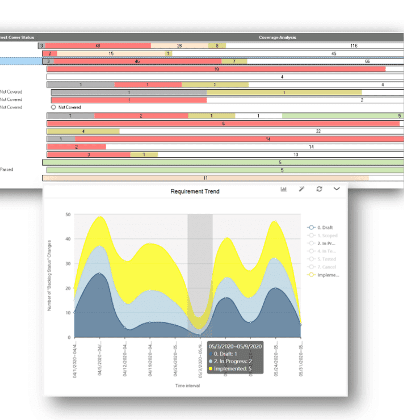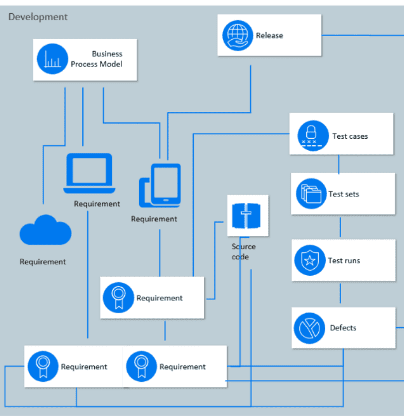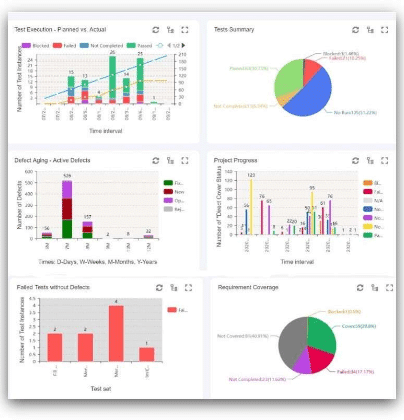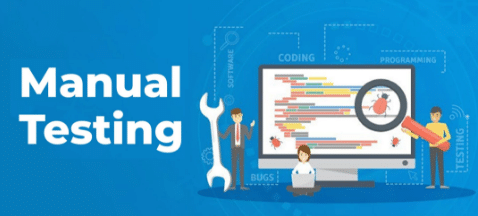Maximize the value of your ALM
Govern quality and implement rigorous, auditable software lifecycle processes.
Maximize the value of your ALM
Govern quality and implement rigorous, auditable software lifecycle processes.

Micro Focus ALM is a complete, cloud-based agile software development management system.
Micro Focus Application Lifecycle Management includes requirements management, agile project management and Micro Focus’ market leading Quality Center test management tools. All are integrated to provide seamless traceability from requirements through project management to testing.
Testing is critical to success, but teams are often too busy to invest the time necessary to complete successful testing cycles. We focus on providing tools, training, and expertise to enable your business to go back to is doing business, and not spending time testing after every regression cycle or two-week development sprint. We build entirely self-contained, modular, and reusable tests to simplify the end-to-end testing process.
ALM Customization &
Configuration
Our team conducts in-depth study of client’s business and project needs, and customizes and configures ALM accordingly. Our ALM services ensure
Test and defect management by using consistent, repeatable software testing processes. Progress of releases are tracked to foster collaboration and visibility.
Requirements management: Defining, managing and tracking requirements through every step of the entire software development lifecycle (SDLC).
Application lifecycle intelligence: Providing real-time insights into who is working on what, when, where, and why. This traceability helps optimize resources.
Enterprise Capabilities: Rich audit history and traceability with support for business rule engines, customizable forms, and user roles permissions.
Adaptable to business processes: Support for Waterfall, Agile and Hybrid methodologies.
Want to know more about Micro Focus ALM

Track and consolidate testing efforts
- Manage application quality with a requirements-driven, risk-based testing approach.
- Improve testing efficiency with automatic test execution, test result collection, and reusable shared assets.
- Access a shared library to maintain consistency across multiple projects.
- Ensure coverage of requirements using the business process model and business process testing.
Enable end-to-end traceability
- Track requirements to tests, defects, and service desk tickets.
- Understand requirement interdependencies to manage complexity.
- Ensure the delivered software fulfills requirements with requirement and test coverage analysis.
- Leverage a traceability matrix to change and test the right part of your applications.


Achieve transparency with analytics
- Gain real-time insight into application quality with out-of-the-box live analysis graphs and health reports and share among stakeholders.
- Use a wizard to easily create custom reports and charts.
- Define KPIs and track release readiness with a scorecard.
- Use composite and trend graphs for advanced analysis.
best testing practices – better test
case development tips and tricks
best testing practices – better test case development tips and tricks
The formality of testing you may experience at your organization or project can vary greatly. A testing process may be very informal — or VERY formal. Where do YOU actually fall in the process? Regardless of the level of formality for the application development lifecycle, there is still a process. What is the four-step test case development process?

Performance Testing – 5 Performance Testing Tips and Techniques
Do you ever skip performance testing or rush through it? Performance testing is one of the many tests that is often rushed or mis-scoped to accommodate the true traffic an application must endure. Here are 5 performance testing tips and techniques that I’ve found useful over my several years as a performance tester.

Performance Testing – How Repeatable Is Your Test?
What is the purpose behind randomizing values in a load test? What is the random sequence seed in LoadRunner/Performance Center? These are questions students often ask in LoadRunner and Performance Center training classes. I want to give you the answers to these questions today, (and you won’t have to sit through a lecture to get them).

Test Management – Get Great Metrics with ALM Project Planning
One common request ALM instructors receive as students walk in the door on the first day of ALM training is, “How can I track application progress as it relates to the project plan?” Understanding the bells and whistles that are available with ALM help students become more productive ALM users.

Best Testing Practices – Better Test Case Development Tips and Tricks
The formality of testing you may experience at your organization or project can vary greatly. A testing process may be very informal — or VERY formal. Where do YOU actually fall in the process? Regardless of the level of formality for the application development lifecycle, there is still a process. What is the four-step test case development process?

Software Testing - Do You Know What You Are Missing in the Software Testing Realm?
I have been an HP Automation Software Test Engineer for the past fourteen years. I am not afraid to admit that I am a total automation junkie! I LOVE automation — and I LOVE the HP Software tools. In my opinion, they are equivalent to the Ferrari in the car world!

Functional Testing - Using ALM Releases Module
TCT Computing Group is a leading functional and performance test consulting and training organization. With over 10 years as a Mercury/HP partner and reseller, TCT Computing has extensive experience implementing best practices in testing.

Test Management - How Much Do You Test
Many people answer with “We must test everything!” Have you ever thought that? How long would it take for one tester to test JUST the front end of an application with 10 data entry screens, each with 10 fields that accept two data types? Remember, you need to accomplish positive and negative testing. If one field will take up to ten characters, then you will need to test one, two, and then three all the way up to ten characters—for EACH field, on EACH screen.

Functional Testing - Manual Testing Made Easy with Sprinter
There are two basic functions of Sprinter — creating tests and running tests. Release 11.5 of Application Lifecycle Management (ALM) added a new Sprinter feature called Plan Mode. This exciting feature allows us to create tests directly in Sprinter as an alternative to using ALM’s Test Plan module for test creation.
Awards & Recognitions
10Pearls is an award-winning digital development company, helping business with product design, development and technology acceleration.

Double – Bottom Lined Co Profits & Social Good

Our CEO and Founder awarded EY Entrepreneur of Year

Digital Experience & Enterprise Mobile Partner

Top Developer DC & Baltimore Metro Area

Recognized as ML/ AI Technology Partner

Digital Experience & Enterprise Mobile Partner
